
The Cenozoic era, from Alticamelus to Zeuglodon
by David Howery
At the end of the Mesozoic era, the
reptiles that had dominated the Earth
disappeared in vast numbers. The pterosaurs,
mosasaurs, and plesiosaurs died
out, and the entire gene pool of the dinosaurs
vanished. There is still no final
explanation for the disaster that eliminated
all but five families of reptiles from
the world.
The reptiles died out quickly ("quickly"
in the sense that geologic time is measured,
that is). This left a sudden vacuum
to be filled by the other two dominant
vertebrates: birds and mammals. Of these
two, the mammals proved to be more
prolific and competitive, expanding into
a
variety of forms and families that relentlessly
took over the land (regardless of
how bizarre they were in appearance).
Some, like whales, returned permanently
to the sea, while bats took to the air
as the
only true flying mammal. Eventually, the
small creatures that lived in the shadow
of
the dinosaurs gave rise to humans, who
now dominate the Earth more completely
than the reptiles did.
The Age of Mammals is called the Cenozoic
era and is divided into seven epochs,
extending from 65 million years ago to
today. From earliest to latest, the epochs
are the:
Paleocene,
Eocene,
Oligocene,
Miocene,
Pliocene,
Pleistocene (Ice Age),
and Holocene (Recent).

The MM describes a few of the interesting
creatures from the Pleistocene, like the
mammoth and sabre-tooth tiger, but there
are many other creatures that can be
added to the AD&D®
game from the whole
Cenozoic era. Only a few such creatures,
like the hyaenodon and the titanothere,
have been described so far.
This article describes more of these
extinct creatures, A place in a DM?s AD&D
game world might exist where prehistoric
creatures survive, or adventurers could
travel back in time to meet them. In either
case, there?s no harm in mixing animals
from different epochs together, even if
it?s
not exactly realistic (this was done with
dinosaurs in the encounter tables in the
DMG, page 188, and for
extinct animals in "Pleistocene
Conditions"
on the same page). This mixing method
makes encounters more varied and interesting,
and it saves the trouble of having
to create an encounter table for each
epoch. Of course, some of these creatures
might be quite common in a DM?s particular
campaign world to begin with (after all,
this is fantasy).
Unless noted otherwise, the creatures
described here are assumed to have the
following statistics in common:
% IN LAIR: Nil (free roaming)
TREASURE TYPE: Nil
SPECIAL ATTACKS: Nil
SPECIAL DEFENSES: Nil
MAGIC RESISTANCE: Standard
INTELLIGENCE: Animal
ALIGNMENT: Neutral
SIZE: L
PSIONIC ABILITY: Nil
Trampling attacks are usually made in
addition to the damage done from a charging
attack with a head butt or horn gore.
Two separate attacks are rolled for the
trampling creature?s feet to strike a
victim.
Experience points for killing or capturing
such creatures should be relatively
easy to calculate, using the guidelines
provided in the DMG, page
85.
A few words about the names of these
creatures would be of help. In many cases,
the genus name of a creature is used in
this article (e.g., Deinotherium). Genus
names are often hard to pronounce as
well, so DMs and players may wish to
invent alternate names for some of these
beasts to be used in campaign play (e.g.,
dagger-jawed elephant for Deinotherium).
In some cases, the genus name serves as
the creature?s common name (e.g., mastodon).
Slight changes in genus names also
create common names (e.g., deinothere,
titanothere, mastodont, zeuglodont).
Making distinctions between what a
mammal looks like and what it really is
can be difficult; Deinotherium was not
a
true elephant, for example, but it looked
like one. Properly identifying the various
types of elephants, mammoths, mastodons,
and kin can be almost impossible. The
marsupial carnivore Thylacosmilus from
South America looked very much like a
sabre-tooth tiger but wasn?t even related
to it. Many other such cases exist. The
DM
should feel free to blur or ignore proper
distinctions if they make no difference
to
the campaign.
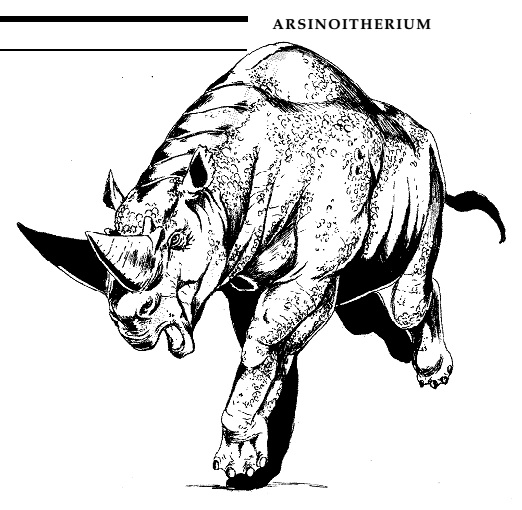
This was an Oligocene beast that looked
much like a rhinoceros, except that it
had
two massive horns side by side on its
nose.
Like a rhinoceros, could
charge for double damage. Low or prone
opponents would be trampled for 2-12/
2-12 hp damage. Treat Arsinoitherium
9-HD rhinoceros, as per the Monster Manual,
except that its horns do 4-16 hp damage
total.
CAT, SABRE-TOOTH
Despite the common name, sabre-tooth
cats and their kin were not tigers or
any
other kind of feline cat; they were a
branch of cats separate from modern
felines. Sabre-tooth cats existed in many
sizes; Smilodon was merely the largest.
Included here is Thylacosmilus, a marsupial
predator that looked almost exactly like
a sabre-tooth cat. Those sabre-tooth cats
smaller than Smilodon can be treated as
the appropriately sized feline cat, except
for bite damage. All sabre-tooth cats
have
a +2 bonus to hit with their fangs. Bite
damage is adjusted as follows:
| Cat size | Bite damage |
| Tiger/lion | 2-11 |
| Jaguar (and
Thylacosmilus) |
2-9 |
| Leopard | 2-8 |
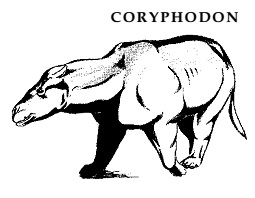
This was a pig-sized Eocene herbivore
which had long molar fangs. For game
purposes, treat Coryphodon as a wild boar
with one attack for 2-7 damage and no
ability to fight at negative hit points.
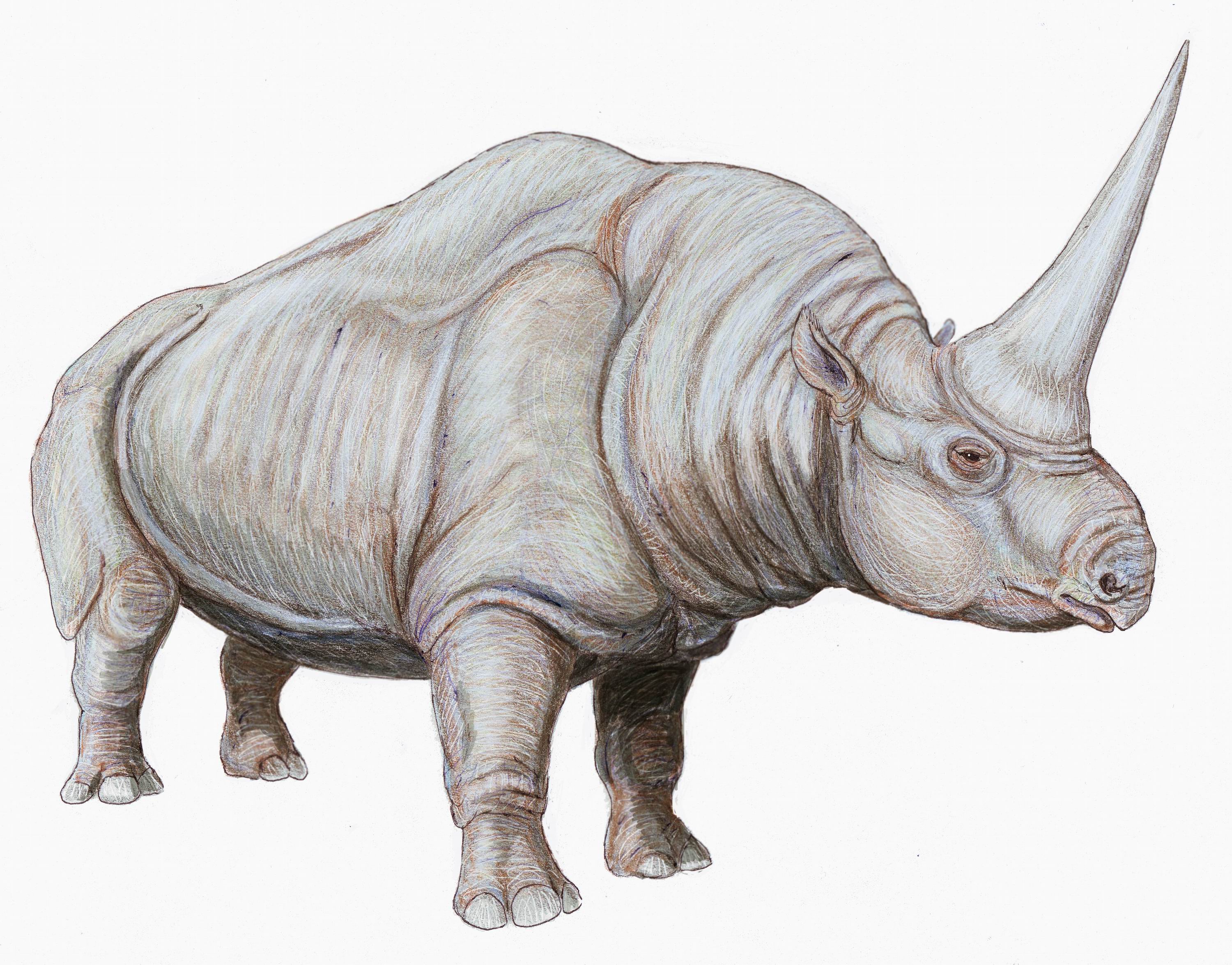
Elasmotherium was a large, shaggy
Pleistocene rhinoceros with a huge horn
on its forehead instead of on its nose.
Treat this mammal as the one-horned
rhinoceros
described in the MM,
doing +2 hp damage with its 6? horn.
FLIGHTLESS BIRD,
GIANT
This classification includes Phororhacos
(MM2, page 54), Diatryma <cf.
Gastornis, wikipedia>,
Aepyornis, and Dinornis (the New Zealand
Moa). These birds lived from the Eocene
to
Recent epochs, usually in isolated areas
because they did not compete well with
mammalian predators. These birds ranged
in size from 7-10? tall (roll 1d4 + 6
for
height). Treat those 7-8? tall as the
axe
beak in the Monster Manual or the clubnek
in the FIEND FOLIO® tome, and
those
9-10? tall as Phororhacos. However,
Phororhacos was an exceptional bird with
a huge head and a powerful beak; the
other birds in this category were much
less combative. While Phororhacos and
Diatryma were definitely carnivores, the
others were most likely omnivores, mixing
plant food with small animals.
HORSE
A time-traveling cavalier will be disappointed
by the Pleistocene horse ancestral
to our own: the tarpan. As it was only
the
size of a pony, it is treated as such
for
game purposes. However, that cavalier
would undoubtedly be delighted with the
giant Pleistocene horse Equus giganteus,
which was larger than any draft horse
today. If the cavalier could capture a
colt,
take it to his own time period, and train
it,
he would have the most awesome warhorse
around. Treat Equus giganteus as
the draft
horse in the MM,
but with 4 HD. If trained as a warhorse,
this horse?s hooves do 1-10/1-10 hp damage.
As a pack animal, it can carry 6,000/
8,500 gp encumbrance.
HYAENODON
This carnivore was not a hyena, nor was
it related to any modern carnivore.
Hyaenodon lived from the Oligocene to
Pliocene epochs. It was narrower and
much less bulky than a true hyena and
had a more rodentlike appearance.
Hyaenodon split off very early from the
true carnivore family and went down a
different evolutionary path; it was a
member
of the creodont family, an early type
of carnivorous mammal.
Gigantic hyenas did exist in the Pleistocene,
standing over 3? high at the shoulder
and as massive as lions today. The statistics
for the Hyaenodon are suitable, though
a
giant hyena?s bite does 1-10 hp damage.
LION, CAVE (Spotted)
Larger than the modern lion, Felis
atrox
resembled them in appearance and habits.
In all probability, lionesses did the
bulk of
the hunting for the pride. Lions can set
up
elaborate hunts, sending part of the pride
to drive prey into an ambush with the
rest
of the lions. This would shock PCs trying
to avoid contact with the big cats.
MAMMOTH
These famous elephants lived in a variety
of climates ranging from the cold subglacial
plains to warm temperate areas.
They also came in a variety of sizes.
The
wooly mammoth, dweller of the cold
plains, was about the same size as the
Indian elephant. The Columbian mammoth
roamed in temperate areas and was a little
larger than the African elephant. The
imperial mammoth, from warm temperate
regions, was the largest of all. Treat
the
imperial mammoth as a normal mammoth,
but with 14 HD and trampling damage of
2-16/2-16 hp.

Even after decades of study, the status
of
Neanderthal man is unclear. He may have
been an ancestor, a contemporary, or both
to modern men. The popular version of
Neanderthal man is a hulking, bow-legged
and beetle-browed human with a receding
forehead. This form was probably an
aberrant type found only in western
Europe. Skeletons found elsewhere are
far
less brutal looking and are quite similar
to
modern humans. In any case, the type
discussed here is the west European Neanderthal
man.
Neanderthal men in AD&D games live
in
small clans of 11-30 members, of which
30% are adult men (round up), 50% are
women, and the remainder are children.
The men are very strong (+1 to strength
rolls, with 18/00 as the maximum and 13
as the minimum. All men in the clan are
barbarian fighters. Women are always 1stlevel
fighters, with 6-9 hit points. One man
in each clan will hive druidic abilities
of
levels 1-4.
Neanderthal men make excellent stone
tools and weapons. Weapons used include
the spear, club, knife, hand axe, and
sling.
All men carry spears, but these are hand
weapons only. The sling can only be used
at its short and medium ranges, since
the
arm structure of Neanderthal man limits
the forward swing.
Although the men are barbarian
fighters,
they lack many of the following abilities
given in UA: 15"
movement rate (they have a 12" maximum
instead), leaping and springing, detection
of illusion and magic, all tertiary skills
except snare building, and summon barbarian
horde. The native terrain of Neanderthals
includes hills, mountains, or
forests. Neaderthal men are as clever
and
devious as normal tribesmen and other
humans.
MASTODON
Another relative of the elephant, mastodons
came in a variety of shapes and sizes,
including Ambelodon (mentioned earlier).
Mastodons appeared in extreme abundance
in the Cenozoic era. Although shorter
than elephants, mastodons were much
heavier in build and so have more hit
dice.
MOROPUS +
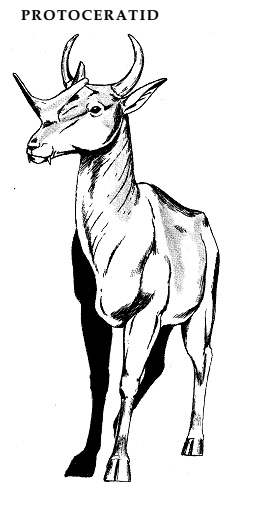
These deerlike animals were noted for
their multiplicity of horns. Protoceras
of
the Oligocene had six spike horns: two
on
the nose, two above the eyes, and two
back of the ears. Syndyoceras of the Miocene
had four spike horns: two on the
nose and two above the eyes. Synthetoceras,
the oddest of all, had two spike
horns above the eyes and one long Yshaped
horn on the nose. Treat all these
creatures as stags, except that each may
make two separate horn attacks. The
damage done is as follows:
| Protoceratid | Damage |
| Protoceras | 2-5/2-5 |
| Syndyoceras | 1-4/1-4 |
| Synthetoceras | 2-5/1-6 |
RHINOCEROS
There was a great variety of these animals
in the Cenozoic, Baluchitherium
(from the MM) being the
largest. The wooly rhinoceros was a
famous resident of the subglacial plains.
One- and two-horned rhinos were common
throughout Pliocene to Recent times.
There were several Oligocene-Pleistocene
species of rhinoceros without horns.
Treat these as normal rhinos, but they
can
only trample for 2-8/2-8 hp damage. Their
charges do only 2-12 hp damage from the
ramming. Only 25% of these species prefer
to bite, doing 2-8 hp damage. The
hornless rhinoceros category can also
include unrelated creatures of similar
form, like the shaggy, ?hippo-bear? Toxodon
and the giant tapir.
TITANOTHERE
Titanotheres were part of a lengthy line
of creatures that died out in the Oligocene.
As they evolved, the titanotheres grew
steadily larger. Brontotherium was the
largest and the last; this is the titanothere
described in the Monster Manual. Earlier
titanotheres can be treated as hornless
rhinoceroses.
UINTATHERIUM ++
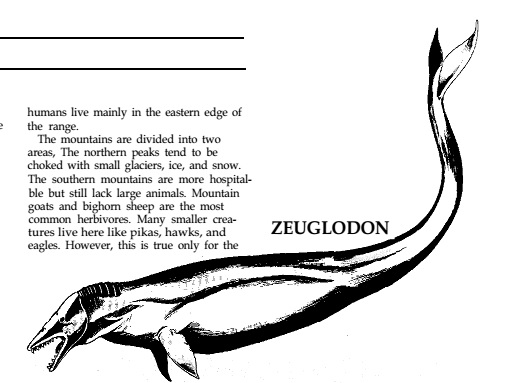
This was a primitive Eocene whale (now
renamed Basilosaurus), around 60? long.
Compared to modern whales, Zeuglodon
had a narrow body, small head, and large
teeth. Treat Zeuglodon as a toothed whale
of 21-30 HD, as described in the MM.
The map shown here is a rough drawing
of part of a continent on a fantasy world
undergoing an Ice Age like our Pleistocene.
This continent could either be
placed in the campaign world or used as
a
setting for time-traveling adventurers.
The glacier itself is a nearly lifeless
region. The top is shifting, unstable,
and
lined with deep crevasses. The most common
creatures here are white puddings,
which consume the ice itself. There are
scattered lairs of remorhaz, ice trolls,
and
white dragons in the more stable areas.
The tundra below the glacier is a very
fertile area, with abundant water and
lush, green grass. Bitter winds continually
blow across the range. There are vast
herds of grazing animals here: mammoths,
bison, horses, caribou, and musk-oxen.
Many of these animals have heavy coats
of
hair and thick layers of fat. Naturally,
the
larger predators are here, too: Smilodon,
cave lions, various bears, and dire wolves.
Hunting parties of humans may be found
anywhere on the tundra, although they
tend to make their homes close to the
western hills. Bugbears are common, since
their long hair protects them from the
chill winds, The tundra is miserably wet
and marshy in summer.
The coniferous taiga forest lies in a
broad belt south of the tundra. The fringe
areas between tundra, forest, and hills
hold the greatest variety of wildlife.
Hunt-
ing parties of humans, Neanderthals, and
all types of humanoids will be found in
the
fringes, hunting ground sloths, forest
caribou, forest bison, forest horses,
and
Irish deer. Many intelligent creatures
make their homes in the fringe areas.
Deep in the forest, elves have the land
to
themselves. Deer are very common here,
and predators tend to be small or medium
in size (like the wolverine, black bear,
wolf, and cougar).
The hills to the west are rugged and
pockmarked with caves. Although the
larger herbivores do not make much use
of the hills, there are deer, sheep, and
goats in abundance. The huge cave bear
lives here, as do the cave lion, cave
hyena,
and dire wolf. Many intelligent creatures
live here too, including Neanderthals,
gnomes, halflings, orcs, and the goblin
races. In the face of this competition,
humans live mainly in the eastern edge
of
the range.
The mountains are divided into two
areas, The northern peaks tend to be
choked with small glaciers, ice, and snow.
The southern mountains are more hospitalble
but still lack large animals. Mountain
goats and bighorn sheep are the most
common herbivores. Many smaller creatures
live here like pikas, hawks, and
eagles. However, this is true only for
the
upper reaches. The lower slopes are covered
with conifers, and the wildlife is
similar to that of the taiga. Only a few
intelligent creatures live here, including
aarakocra, dwarves, and taer.
South of the taiga, the land breaks up
into hills and vast temperate plains.
These
plains have a variety of wildlife similar
to
that of the tundra, except that the caribou
and musk-ox are absent. Bison are the
most common herd animals. Several types
of antelope will be seen. There are some
unusual creatures here, like the giant
vulture (Teratornis) and the giant
horse.
Predators include sabre-tooth cats, wolves,
and grizzlies. Again, the fringe areas
between hills, forest, and plains are
often
roamed by hunting parties of intelligent
creatures, since the greatest amount of
wildlife will be found there. Humans live
in many areas on the plains, but most
are
near the hills or along the river. The
smaller demi-humans live in the hills,
competing for food and living space with
the various humanoids there.
The rivers look unappealing, as they are
cloudy with silt and oxygen. They are
nevertheless very important sources of
food. Salmon, trout, and huge sturgeons
thrive in the waters. Likewise, the sea
is
not unusual, although there is no civilized
sea traffic. Great numbers of whales and
seals can be seen. Many human villages
are found on the ocean shores.
Using these notes as guidelines, the DM
should be able to create an interesting
AD&D game Ice Age setting. The setting
could be extended to subtropical and
tropical lands without difficulty. These
regions had much the same wildlife as
in
recent times, although there were several
added species like glyptodonts, sivatheres,
and hornless rhinoceroses. For an excellent
background on adventuring peoples
in the Ice Age, see "Thrills
and Chills,"
from DRAGON® issue #68 and reprinted
in
the Best of DRAGON Magazine Anthology,
vol. V.
Table 1
Animals of the Pleistocene from the
AD&D game
| Ape, gorilla | Lion (all) |
| Baboon | Otter |
| Badger | Owl |
| Bat | Porcupine, giant |
| Beaver, giant | Ram, giant |
| Boar (all) | Rat |
| Buffalo | Rat, giant |
| Camel, wild | Raven |
| Cat, wild | Rhinoceros (all) |
| Cheetah | Skunk |
| Cat, wild | Snake |
| Crocodile | Spider, large |
| Dog, wild | Squirrel |
| Eagle | Stag |
| Elephant (all) | Stag, giant |
| Falcon/hawk | Swan |
| Flightless bird | Tiger |
| Goat, giant | Vulture |
| Herd animal | Vulture, giant |
| Hippopotamus | Wolf |
| Hyena | Wolf, dire |
| Irish deer | Wolverine |
| Jackal | Weasel |
| Leopard | - |
Table 2
Encounter Table: Glacier
| 1d20 | Result |
| 1-2 | Dragon, white |
| 3-13 | Pudding, white |
| 14 | Remorhaz |
| 15-17 | Toad, ice |
| 18-20 | Troll, ice |
Table 3
Encounter Table: Mountains
| 1d20 | Result |
| 1 | Aarakocra |
| 2-3 | Bear, cave |
| 4 | Dwarf, mountain |
| 5-6 | Eagle |
| 7-9 | Falcon/hawk |
| 10-12 | Goat, giant |
| 13-14 | Lion, mountain |
| 15-17 | Ram, giant |
| 18-19 | Raven |
| 20 | Taer |
Table 4
Encounter Table: Swamp
| 1d20 | Result |
| 1-2 | Ambelodon |
| 3-4 | Cat, wild |
| 5-7 | Irish deer |
| 8-9 | Lion, mountain |
| 10-11 | Mastodon |
| 12 | Men, tribesmen |
| 13-14 | Rhino, hornless (tapir) |
| 15-16 | Snake, poisonous |
| 17-19 | Stag, giant (moose) |
| 20 | Troll <?> |
Table 5
Encounter Table: Tundra
| 1d20 | Result |
| 1 | Bear, brown |
| 2 | Boar, short-faced |
| 3-4 | Bison |
| 5-6 | Bison, giant |
| 7 | Bugbear |
| 8 | Horse, tarpan <?> |
| 9 | Lion, cave |
| 10 | Mammoth, woolly |
| 11 | Mastodon |
| 12 | Men, tribesmen |
| 13 | Musk-ox |
| 14 | Rhino, woolly |
| 15-17 | Stag (caribou) |
| 18 | Wolf |
| 19 | Wolf, dire |
| 20 | Wolverine |
Table 6
Encounter Table: Taiga Forest
| 1d20 | Result |
| 1-4 | Bear, black |
| 5-8 | Bear, brown |
| 9-12 | Bear, grizzly |
| 13-16 | Beaver, giant |
| 17-22 | Bison |
| 23-26 | Elf, grugach |
| 27-30 | Ground sloth (Mylodon) |
| 31-35 | Horse, tarpan <?> |
| 36-41 | Irish deer |
| 42-45 | Lion, mountain |
| 46-49 | Mammoth, woolly |
| 50-53 | Mastodon |
| 54-57 | Men, neanderthal |
| 58-61 | Men, tribesmen |
| 62-65 | Muskox |
| 66-69 | Porcupine, giant |
| 70-73 | Sabre-tooth, leopard |
| 74-76 | Stag (caribou, wapiti) |
| 79-83 | Stag, giant (moose) |
| 84-88 | Tiger |
| 89-92 | Wolf |
| 93-96 | Wolf, dire |
| 97-00 | Wolverine |
Table 7
Encounter Table: Hills
| 1d20 | Result |
| 1 | Bear, cave |
| 2 | Gnome |
| 3 | Goat |
| 4 | Goblin |
| 5 | Halfling |
| 6 | Hobgoblin |
| 7 | Hyena |
| 8 | Lion, cave |
| 9 | Men, neanderthal |
| 10 | Men, tribesmen |
| 11 | Ogre |
| 12 | Orc |
| 13 | Ram |
| 14 | Sabre-tooth leopard |
| 15 | Sabre-tooth lion |
| 16 | Smilodon |
| 17-18 | Stag |
| 19 | Wolf |
| 20 | Wolf, dire |
Table 8
Encounter Table: Temperate Forest
| d100 | Result |
| 1-4 | Baluchitherium |
| 5-8 | Bear, black |
| 9-12 | Boar, wild |
| 13-17 | Cattle, auroch |
| 18-21 | Deinotherium |
| 22-25 | Elf, wood |
| 26-29 | Ground sloth (Megatherium) |
| 30-33 | Horse, tarpan |
| 34-37 | Lion, mountain |
| 38-41 | Mammoth, Columbian |
| 42-44 | Men, tribesmen |
| 45-48 | Owl |
| 49-52 | Porcupine, giant |
| 53-56 | Protoceras |
| 57-60 | Rhino, hornless |
| 61-64 | Rhino, one-horned |
| 65-68 | Sabre-tooth leopard |
| 69-74 | Stag |
| 75-78 | Stag, giant |
| 79-81 | Syndyoceras |
| 82-85 | Synthetoceras |
| 86-89 | Tiger |
| 90-93 | Uintatherium |
| 94-00 | Wolf |
Table 9
Encounter Table: Temperate Plains
| 1d100 | Result |
| 1-3 | Arsinoitherium |
| 4-6 | Astrapotherium |
| 7-9 | Baluchitherium |
| 10-12 | Bear, grizzly |
| 13-16 | Bison |
| 17-20 | Cattle, auroch |
| 21-23 | Coryphodon |
| 24-26 | Elasmotherium |
| 27-29 | Flightless bird, giant |
| 30-32 | Gnolls |
| 33-36 | Herd animal |
| 37-39 | Horse, giant |
| 40-42 | Horse, tarpan |
| 43-45 | Hyena |
| 46-48 | Hyaenadon |
| 49-51 | Lion |
| 52-54 | Lion, cave |
| 55-57 | Macrauchenia |
| 58-60 | Mammoth, Columbian |
| 61-63 | Mammoth, Imperial |
| 64-66 | Men, tribesmen |
| 67-69 | Rhino, hornless |
| 70-72 | Rhino, one-horned |
| 73-75 | Rhino, two-horned |
| 76-78 | Sabre-tooth jaguar |
| 79-81 | Sabre-tooth leopard |
| 82-84 | Sabre-tooth lion |
| 85-87 | Smilodon |
| 88-91 | Stag |
| 92-94 | Uintatherium |
| 95-97 | Vulture, giant |
| 98-00 | Wolf |
Table 10
Encounter Table: Savannah
| 1d100 | Result |
| 1-4 | Alticamelus |
| 5-8 | Baboon |
| 9-12 | Boar, giant |
| 13-16 | Brontotherium |
| 17-20 | Buffalo |
| 21-24 | Cheetah |
| 25-28 | Dog, wild |
| 29-32 | Elephant |
| 33-36 | Flightless bird |
| 37-40 | Ground sloth (Mylodon) |
| 41-44 | Glyptodon |
| 45-48 | Gnolls |
| 49-52 | Herd animal |
| 53-56 | Hyena |
| 57-60 | Jackal |
| 61-64 | Leopard |
| 65-68 | Lion |
| 69-72 | Macrauchenia |
| 73-76 | Men, tribesmen |
| 77-80 | Moropus |
| 81-84 | Rhino, hornless |
| 85-88 | Rhino, one-horned |
| 89-92 | Rhino, two-horned |
| 93-96 | Sivatherium |
| 97-00 | Vulture, giant |
Table 11
Encounter Table: Rain Forest
| 1d20 | Result |
| 1 | Ape, gorilla |
| 2-3 | Boar, warthog |
| 4 | Gigantopithecus |
| 5 | Ground sloth (Mylodon) |
| 6 | Glyptodon |
| 7-9 | Herd animal |
| 10 | Jaguar |
| 11 | Leopard |
| 12 | Men, tribesmen |
| 13 | Rat, giant |
| 14 | Rhino, hornless |
| 15 | Rhino, one-horned |
| 16 | Sivatherium |
| 17 | Snake, constrictor |
| 18 | Snake, poisonous |
| 19 | Spider, large |
| 20 | Tiger |
Other extinct mammals
In addition to the creatures described in
this article, many animals from the Monster
Manuals existed in the late Pleistocene.
Obviously, specially bred animals
(like mules and war horses) were not
around. Those creature alive during the
Pleistocene are listed in Table 1. Some are
detailed below.
Other extinct creatures, like creodonts
and tillodonts, are either little known (i.e.,
little fossil evidence of them has been
found) or are comparable to other animals.
For example, creodonts could be
treated as weasels, giant weasels, or dogs.
DMs who are interested in these creatures
can read about them and make their own
statistics and comparisons.